#fondazione archivio luigi nono
Text
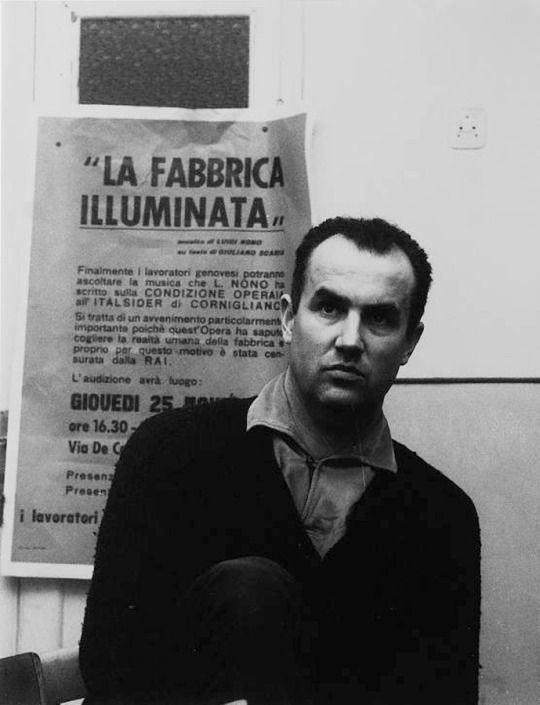
Luigi Nono, La fabbrica illuminata, Texts by Giuliano Scabia and Cesare Pavese (from Due poesie a T), 1964 [Fondazione Archivio Luigi Nono, Venezia]
«Agli operai della Italsider di Genova» (dedication)
#art#music#photography#la fabbrica illuminata#luigi nono#giuliano scabia#cesare pavese#fondazione archivio luigi nono#1960s
38 notes
·
View notes
Text
nanni balestrini_ il rapporto con luigi nono e il "contrappunto dialettico alla mente"
Nanni Balestrini (2 luglio 1935 – 19 maggio 2019) poeta, scrittore e membro del Gruppo 63 ricorda, insieme al musicologo Veniero Rizzardi, la sua collaborazione con Luigi Nono negli anni Sessanta. Balestrini ha curato i testi del brano Contrappunto dialettico alla mente (1968) ma il rapporto col compositore veneziano va oltre questo episodio.
Venezia, 5 dicembre 2013
Una produzione Fondazione…
youtube
View On WordPress
#cambio di paradigma#Contrappunto dialettico alla mente#Fondazione Archivio Luigi Nono#Luigi Nono#musica#musica di ricerca#musica sperimentale#musique de recherche#Nanni Balestrini#neoavanguardia#scrittura di ricerca#scritture di ricerca#Veniero Rizzardi#Youtube
0 notes
Photo

David Borovskij, preparatory study for Luigi Nono- ‘Al gran sole carico d'amore’ (1972-1974), original staging, Teatro Lirico di Milano, Milano, 1975 [Fondazione Archivio Luigi Nono, Venezia].
7 notes
·
View notes
Text
The Invisible Church
It had been about 100 years since anyone last saw her. Rumors about an unlikely find of Marco Polo's remains in her depths, and the supposed beauty of an unseen altar announced her delayed return. I don't remember her façade —even when she stood at the front of San Lorenzo square, I couldn't describe it— now completely covered with colorful banners, announcing the opera of the composer Luigi Nono. [1]

Read also “Teatro del Mondo: An Odyssey”, “Emblem Of A Better Germany?”, “The Greek Experiment” and “The Introverted Seismograph”
The structure designed by Renzo Piano on that evening occupied it all; a maze of scaffolding, where to navigate it was to play a role in it, and a brief description of the "huge musical instrument and sounding board that housed the stage, audience and orchestra" [2] to be seen from the seats at the center of that all-encompassing stage.

Music Space for Prometeo Opera by Renzo Piano Architects (1984), San Lorenzo Church, Venice, Italy | Fondazione Renzo Piano

Music Space for Prometeo Opera Section Drawing by Renzo Piano Architects (1984), San Lorenzo Church, Venice, Italy | Fondazione Renzo Piano
Everything was ruddy, shadowy, and indistinct. Even more so when they had just lit up the stage and my eyes were dazzled, and I was barely able to see that enormous door wide open, through the vast and incredible hole that swallowed the whole of the lower portion of the altarpiece.
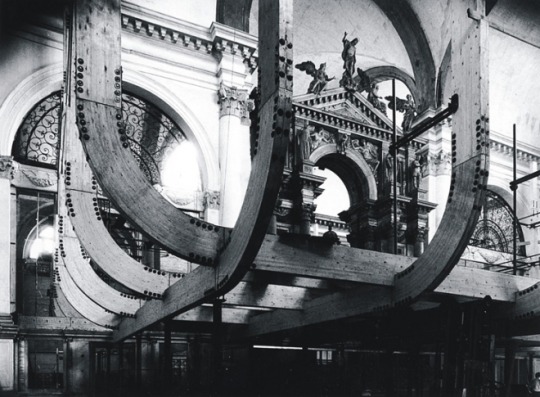
Music Space for Prometeo Opera by Renzo Piano Architects (1984), San Lorenzo Church, Venice, Italy | Fondazione Renzo Piano
The musicians positioned themselves along the staircase, the lights dimmed and Prometheus began to fill the room with its flame, in a musical conversation between the wooden panels, the omnipresent scaffold and the hidden walls of the church.

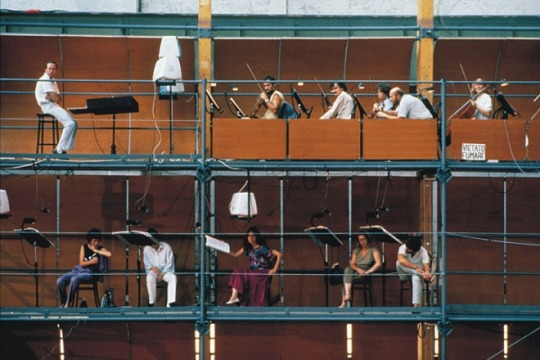

Prometeo Opera Musicians Rehearsal (1984) in San Lorenzo Church, Venice, Italy | Fondazione Renzo Piano
I like to believe the music made her visible for a moment and I was able to see her face —even if covered— for the night.
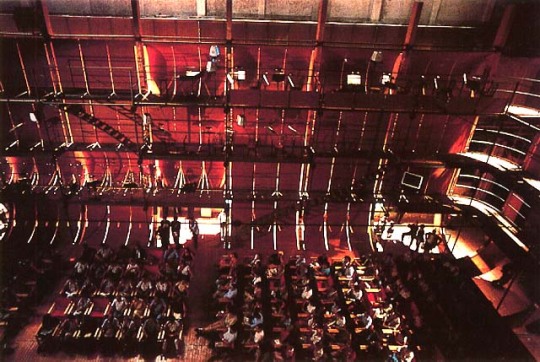
Prometeo Opera Opening Night (1984), San Lorenzo Church, Venice, Italy | Fondazione Renzo Piano
Maybe it was just the illusion of wanting to see her real face. Maybe it was the face of Prometheus before the doors of light and thunder closed again. [3]
“Black here and white there-in patches. She’s a kind of half-breed, and the colors come off patchy in places instead of mixing. I’ve heard of such things before. And it’s the common way with these venues, as anyone can see.” [4] The reality is that the church was invisible. She had always been. [5] Piano and Nono's imagination created a place that fitted in with what they thought they knew about her glaring real absence. They dressed her in masks, clothes and artifices for her to become them in time. In this little church, form was background. What we witnessed there was not a mere representation of Prometheus; it was Prometheus. Beyond the brief moments that her stolen radiance lasted, she would stay only Prometheus. [6] For the more they included her in the conversation, the more invisible she was to all the present. The church was silent and nodding, and those were her best qualities; a magnificent vision of what real invisibility means —the mystery, the power, the freedom, the licentiousness— where they saw no inconvenience in disposing of the helpless building. They arrived at the conclusion that a destitute church could become the manifestation of anything.
Twenty-eight years elapsed since the Italian music and pyrotechnics, when the Mexicans arrived with their ideas for promoting folklore. [7]
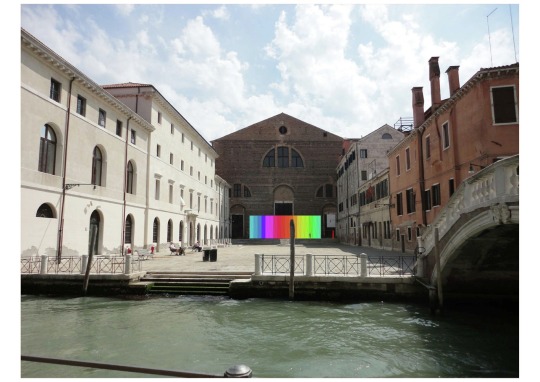
Culture Under Construction - The Collectivity of Cultural Space Installation Photo Montage 2012, San Lorenzo Church, Venice, Italy | Arquine
The same biennial, the same pretensions, the same assumptions, the same scaffold, that now covered her from the outside; new brighter and more colorful banners fluttered in the Venetian summer breeze laying over the church once more.

Culture Under Construction - The Collectivity of Cultural Space Mexican Pavilion at the Venice Architecture Biennale 2012, San Lorenzo Church, Venice | Arquine
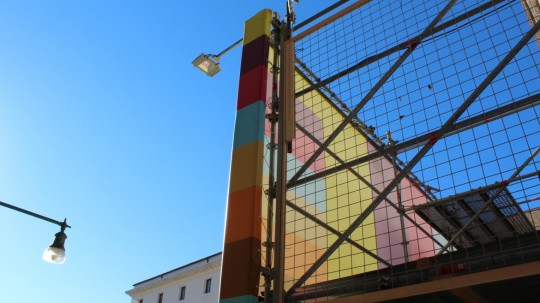
Culture Under Construction - The Collectivity of Cultural Space Mexican Pavilion at the Venice Architecture Biennale 2012, San Lorenzo Church, Venice | Archdaily

Culture Under Construction - The Collectivity of Cultural Space Mexican Pavilion at the Venice Architecture Biennale 2012, San Lorenzo Church, Venice | Biennale di Venezia
The gesture stood as a true triumph of artifice over reality, choosing the most crowded moments of its square to show the cultural power of a distant country, which found itself eagerly seeking to show its appreciation for the ruin, preservation and millennial constructive capacities. They decided to elevate the scaffold and extended it to the façade —as the Italians had done in their time to her interior— covering the church’s entrance in its entirety with a pompous mask.
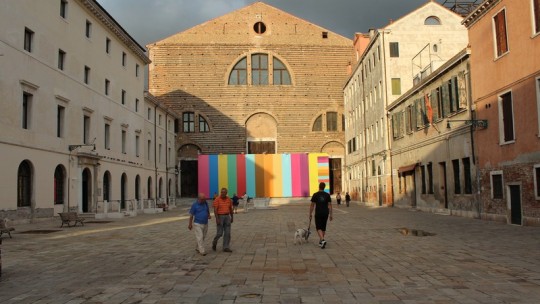
Culture Under Construction - The Collectivity of Cultural Space Mexican Pavilion at the Venice Architecture Biennale 2012 Front Facade 2012, San Lorenzo Church, Venice, Italy | Arquine
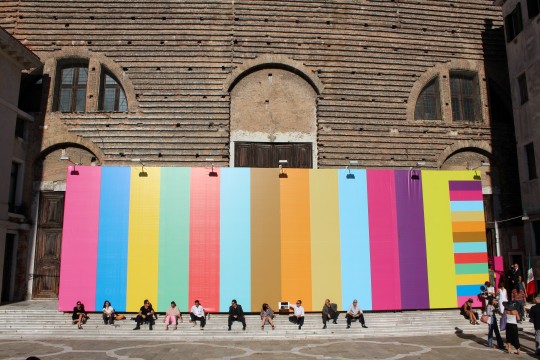
Culture Under Construction - The Collectivity of Cultural Space Mexican Pavilion at the Venice Architecture Biennale 2012 Front Facade 2012, San Lorenzo Church, Venice, Italy | Biennale di Venezia
With some ingenuity, imagination, but above all money, she assured them a visible place at the Biennale [8] at the cost of her own. But pacts are easy to break, especially if they are written on air and promised from afar [9]. They would soon realize the terrible contradiction: after the frantic gestures to recover the church by Mexico —which surprised more than one— the headlong pace after the summer that swept her away, the inhuman bludgeoning of all the tentative advances of curiosity, the taste for winter that led to the closing of doors, the pulling down of blinds, the extinction of candles and lamps after the party [10], the church was still empty.

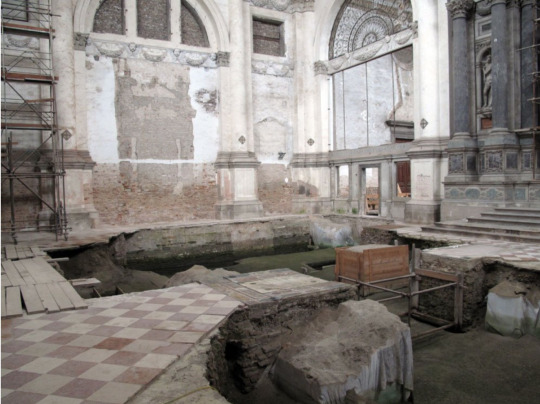
San Lorenzo Church Interior 2012, San Lorenzo Church, Venice, Italy | Arquine
She disappeared for a while, but with the return of the Biennale-eaggered tourists that the summer brings, so did the scaffolding, this time to cover the wounds underneath Ariel Gusizk's Cordiox [11].

Cordiox Mexican Pavilion at the Venice Art Biennale 2013 Installation 2013, San Lorenzo Church, Venice, Italy | Arquine

Still from Video Cordiox Mexican Pavilion at the Venice Art Biennale 2013 Installation in progress 2013, San Lorenzo Church, Venice, Italy | Marco Mosco

Cordiox Mexican Pavilion at the Venice Art Biennale 2013 Installation in progress 2013, San Lorenzo Church, Venice, Italy | Arquine
The inner emptiness was of absolute clarity; her invisibility transcended the concealment of her ordinary face. The Church for the first time was half-bare, and yet, the only thing we could —we wanted— see were her improvised clothes. Those scaffolds that had already become the building; whether to cover its altars, its ceilings, its facades, or its wounds, allowing us to see in time those transitory garments that, by opposition, had turned her into a mystery, a wrapped caricature, a silhouette. She would appear and disappear with the Biennale, but no one would notice or care anymore, so they cut her loose. When they removed the scaffold, banners and the lights, they only verified what we already knew. She had long been gone.

Cordiox Mexican Pavilion at the Venice Art Biennale 2013 Installation 2013, San Lorenzo Church, Venice, Italy | El Universal
***
VAB 05: Tania Tovar Torres

Tania Tovar Torres is an architect, writer and curator. She is co-founder and director of Proyector, a curatorial platform based in Mexico City devoted to the promotion of architecture research projects. Her practice focuses on alternative methods of architectural production and consulting for research and curatorial projects. She is currently professor at Universidad Iberoamericana and appointed curator of the Architecture Pavilion of the 2019 and 2020 Mexican Design Open. Previously, she worked at the Canadian Centre for Architecture in Montreal and at the Arthur Ross Architecture Gallery in New York. Tania holds a Master's degree in Critical, Curatorial and Conceptual Practices in Architecture from Columbia University and a Bachelor of Architecture from the Universidad Nacional Autónoma de México UNAM.
-
Notes:
1. Prometeo (Prometheus) is an "opera" by Luigi Nono, written between 1981 and 1984 and revised in 1985. Nono scornfully labeled Prometeo a "tragedia dell'ascolto", a tragedy of listening. The premiere of the first version was held at the Church of San Lorenzo in Venice on 25 September 1984. [Fondazione Archivio Luigi Nono ONLUS]
2. Designed exclusively for Luigi Nono’s opera Prometeo, this large acoustic space that can be fully dismantled, offered a chance to experiment with the profoundly intimate, even fruitful relationship that can exist between music and architecture. The traditional concept of the concert hall was revolutionized for the event, turning the space into a huge musical instrument, a resonant box housing the stage, the audience and the orchestra. The structure had to be erected first in the church of San Lorenzo, in Venice, as well as in the disused Ansaldo factory in Milan. [RPBW Architects - Renzo Piano Building Workshop, Prometeo Musical Space]
3. The design came to life in 1984 for the first performance at the deconsecrated church of San Lorenzo, in Venice as part of the XLI Biennale/ Musica, after which the structure was dismantled and reassembled a year later at the former Ansaldo factory in Milan. [RPBW Architects - Renzo Piano Building Workshop, Prometeo Musical Space]
4. Wells, H. G. 1998. The Invisible Man. Wickford, R.I.: North Books.
5. Over the centuries, San Lorenzo was known as a centre for music more so than a church, where celebrated seventeenth-century composer Antonio Vivaldi, performed and rehearsed. The church suffered damages during the Napoleonic War and, in 1810, was deconsecrated and all decorations except the main altar were removed. It closed to the public in 1865 and, in the early twentieth century, underwent a series of archaeological excavations, in search of the remains of Marco Polo. [San Lorenzo, Ocean Space]
6. The installation created by Renzo Piano for Luigi Nono's opera Prometheus in 1984 created "an invisible theatre where the production of sound and its projection into space are fundamental to generating dramaturgy". For Nono, music and sound predominated over images and the written word, as much as the building that served only as background for its stage to open up new dimensions of meaning and possibilities for listening. [La Máquina Sonora, Arquine]
7. The 15th of September 1984 was the last time that San Lorenzo was opened with the final concert performance by Luigi Nono with the architectural, acoustic and scenographic proposal of Renzo Piano. After 28 years of being closed, the old church reopens on August 27th with the inauguration of the Mexican Pavilion for the International Architecture Exhibition of the Venice Biennale, which was on display until November 25th. Mexico reached an agreement for nine years with the Municipality of Venice in order to restore the heritage site and use it as a Mexican venue for the biennials of art, architecture, film, dance, music and theater for the next nine years. [Las Capas De San Lorenzo, Arquine]
8. The Mexican State signed, in July 2012, the contract with the Municipality of Venice to have in comodato the former Church of San Lorenzo for nine years, not only committed to restore the property, but to have a constant cultural programming, allowing the entrance to local public one day a month and acquire an insurance against damages to third parties. [México Se Compromete A Darle Vida A La Ex Iglesia De San Lorenzo]
9. El INBA Excluye A San Lorenzo En Bienal De Arquitectura De Venecia
10. Wells, H. G. 1998. The Invisible Man. Wickford, R.I.: North Books
11. After having recovered with the 13th International Architecture Exhibition of the Venice Biennale (Culture under Construction), the Mexican Pavilion for the 55th International Art Exhibition of the Venice Biennale was opened in the old Church of San Lorenzo (The Layers of San Lorenzo). For this edition, the Mexican artist Ariel Guzik (Mexico City, 1960) was invited, who proposed Cordiox, a complex machine that describes sonorously the environment where it is located, spreading a crystalline, subtle and expansive tonal cadence, which favors an exceptional listening experience. [La Máquina Sonora | Arquine]
2 notes
·
View notes
Photo

Nono Luigi, Al gran sole carico d'amore / Au grand soleil d'amour chargé, (work notes), Arrangement by Irlando Danieli, Texts by Bertolt Brecht, Tania Bunke, Fidel Castro, Ernesto “Che” Guevara, Dimitrov, Maksim Gorkij, Antonio Gramsci, Lenin, Karl Marx, Louise Michel, Cesare Pavese, Arthur Rimbaud, Celia Sánchez, Haydée Santamaría, Edited by Luigi Nono and Jurj Ljubimov, Ricordi, Milano, 1972-1974 [Fondazione Archivio Luigi Nono, Venezia]
4 notes
·
View notes
Photo
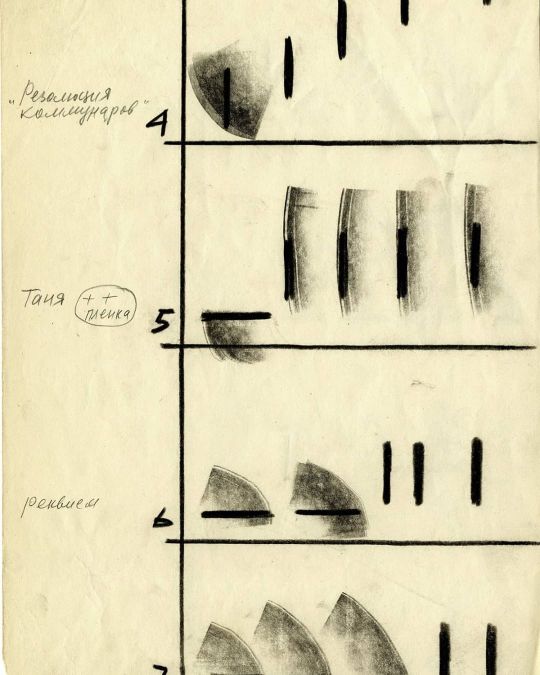
David Borovskij, preparatory study for Luigi Nono: 'Al gran sole carico d'amore' (1972-1974), original staging, Teatro Lirico di Milano, Milano, 1975 [Fondazione Archivio Luigi Nono, Venezia] https://www.instagram.com/p/CAKryY6peZV/?igshid=2ia2smdp3ahm
0 notes
Photo

Luigi Nono, Sketch for ‘Prometeo. Tragedia dell'ascolto’. Study for colours, Winter 1983-1984. [Fondazione Archivio Luigi Nono, Venezia]
0 notes
Text
Luigi Nono – I film di famiglia
Luigi Nono – I film di famiglia
5
Mag
Nei prossimi giorni la Fondazione Archivio Luigi Nono renderà gratuitamente disponibile la visione del documentario “I film di famiglia“, realizzato da Serena Nono a partire dai filmini amatoriali realizzati dai suoi genitori fra il 1959 e il 1974.
Ve ne parlo perché tra gli amici e collaboratori di Nono che compaiono nel film ci dovrebbero essere pure gli Inti-Illimani.
agg…
View On WordPress
0 notes
Link
MACERATA – Il secondo appuntamento della trentasettesima edizione della Rassegna di Nuova Musica, firmata dal direttore artistico Gianluca Gentili, martedì 19 marzo, ore 21.15, sempre al Teatro Lauro Rossi di Macerata, è dedicato a Stefano Scodanibbio – maceratese e fondatore della Rassegna – e al suo strumento, il contrabbasso, e non sarà di sola musica, ma anche di parole sulla musica.
La serata infatti prevede all’interno del concerto, affidato musicalmente all’Ensemble Ludus Gravis, anche la presentazione da parte di Andrea Cortellessa del volume di scritti e taccuini di Scodanibbio “Non abbastanza per me” a cura di Giorgio Agamben ed edito da Quodlibet.
In apertura di concerto Alisei (versione per dieci contrabbassi,1986) di Scodanibbio e anche il suo Ottetto per otto contrabbassi (2010/2011), due brani compresi nel cd “Alisei” uscito recentemente per l’etichetta discografica ECM; quindi Fury Road – Omaggio a Stefano Scodanibbio per contrabbasso (2016) di Daniele Roccato e Cupio Dissolvi per otto contrabbassi e nastro (2017) di Fabio Cifariello Ciardi, ispirato alla voce di Martin Luther King durante il celebre discorso “I have a Dream” è dedicato “a Daniele Roccato e agli strabilianti interpreti del Ludus Gravis”. Il programma musicale è completato dalla prima esecuzione italiana di Seascapes X per otto contrabbassi (2018) di Nicola Sani.
L’Ensemble Ludus Gravis è composto dai contrabbassisti Giacomo Piermatti, Francesco Platoni, Alessandro Schillaci, Stefano Battaglia, Paolo Di Gironimo, Andrea Passini, Simone Masina, Mauro Tedesco, Rocco Castellani, Alessio Cordaro e ha come solista e direttore Daniele Roccato, artefice di un memorabile concerto l’anno scorso all’Asilo Ricci.
Ensemble Ludus Gravis Ludus Gravis è un ensemble di soli contrabbassi. Fin dal suo debutto nel 2010 ha rappresentato un’autentica novità nel panorama musicale contemporaneo attirando l’attenzione di compositori che hanno segnato la storia della musica e ricevendo inviti da molti dei più prestigiosi festival musicali europei. Per Ludus Gravis hanno scritto, tra gli altri, Hans Werner Henze, Sofia Gubajdulina, Terry Riley, Gavin Bryars, Julio Estrada, Stefano Scodanibbio, Fabio Cifariello Ciardi, Luigi Ceccarelli, Nicola Sani, Filippo Perocco, Edgar Alandia, Tonino Battista.
La sua attività si estende nei campi del teatro, della danza, della letteratura, della poesia, delle arti visive, del cinema muto e contempla progetti con accompagnamento d’orchestra e con live electronics. È stato ospite di prestigiosi festival in Italia e all’estero: La Biennale di Venezia, Ravenna Festival, Rassegna di Nuova Musica (Macerata), I Concerti del Quirinale di RadioTre (Roma), AngelicA (Bologna), Società Aquilana dei Concerti “B. Barattelli”, Associazione Alessandro Scarlatti (Napoli), Màntica Festival (Cesena), Imago Dei (Austria), Music of Changes e Gaida (Lithuania), I Cantieri dell’Immaginario (L’Aquila), Unicum (Slovenia), Borealis e Vinterfestuka (Norvegia), Ad Lucem Introvert Art Festival (Lettonia), Suså Festival (Danimarca), Lux Aeterna (Germania), Musica D’Hoy, VI Ciclo de Conciertos de Mùsica Contemporànea , Fundaciòn BBVA (Spagna).
L’ensemble è composto generalmente da otto contrabbassi ma il numero varia da quattro a dodici in relazione al programma. Ludus Gravis ha registrato per le etichette discografiche ECM e WERGO. BBC Radio, Rai Radio3 e il canale televisivo SkyArte hanno trasmesso suoi concerti. Il gruppo è nato dall’incontro tra Stefano Scodanibbio e Daniele Roccato.
Il concerto, come tutti quelli della Rassegna di Nuova Musica, sarà registrato e trasmesso da Rai Radio 3. I biglietti (Biglietteria dei teatri in piazza Mazzini e circuito online Vivaticket) hanno un costo di 5 euro (intero) e 3 euro (ridotto; gli studenti UNIMC potranno usufruire di ulteriori agevolazioni). Per l’appuntamento del 21 marzo all’Ex Asilo Ricci, considerato il limitato numeri di posti, si raccomanda l’acquisto del biglietto con anticipo.
La XXXVII Rassegna di Nuova Musica è realizzata con il contributo del Comune di Macerata e con il supporto logistico/organizzativo dell’Associazione Arena Sferisterio; si avvale della collaborazione dell’UNIMC e dell’Accademia di Belle Arti di Macerata. Importante presenza è inoltre quella dell’Orchestra Filarmonica Marchigiana con la quale il Festival ha realizzato negli ultimi anni numerosi progetti originali. Quest’anno ha inoltre il sostegno del MiBACT e di SIAE, nell’ambito dell’iniziativa “Sillumina – Copia privata per i giovani, per la cultura”.
Fabio Cifariello Ciardi (Roma, 1960) Interessato alla percezione, alla memoria e all’uso della tecnologia applicata a diversi fenomeni che raccontano il nostro presente, Fabio Cifariello Ciardi si dedica alla musica strumentale, a quella elettroacustica e alla creazione di opere multimediali. Di recente ha cominciato a interessarsi alla trascrizione strumentale delle inflessioni e dei ritmi della voce parlata e per la composizione della propria musica ha creato software originali dedicati al calcolo della dissonanza, la spazializzazione del suono, la sonificazione in tempo reale degli andamenti dei mercati finanziari e la trascrizione strumentale di voci parlate.
Per l’originalità della sua ricerca ha ricevuto premi e commissioni da istituzioni musicali nazionali ed internazionali. A partire dal 2001, con il collettivo Edison Studio, compone e realizza dal vivo le colonne sonore per diversi film muti e progetti di collaborazione con performer quali il percussionista Mahamad Gavhi Helm, il trombonista Ivo Nilsson e il contrabbassista Daniele Roccato. È titolare della cattedra di Composizione presso il Conservatorio di Trento, collabora con il Dipartimento di Sociologia dell’Università di Trento ed è uno dei conduttori della trasmissione Radio3 Suite.
Daniele Roccato (Adria, 1969) Contrabbassista solista e compositore, è stato invitato a suonare in molti dei festival e delle sale da concerto più prestigiose del mondo, spesso presentando proprie composizioni. Per lui hanno scritto e trascritto Gavin Bryars, Fabio Cifariello Ciardi, Julio Estrada, Ivan Fedele, Sofia Gubajdulina, Hans Werner Henze, Filippo Perocco, Terry Riley, Nicola Sani, Stefano Scodanibbio. Gubajdulina ha dichiarato: “…la sua interpretazione mi ha totalmente sconvolta. Non ho mai sentito un contrabbasso suonare in questo modo” RAI (RadioTre).
Assieme a Scodanibbio ha fondato l’ensemble di contrabbassi “Ludus Gravis”, del quale è concertatore e solista. In ambito teatrale ha collaborato con Vitaliano Trevisan, Chiara Guidi e con il Teatro delle Albe, per la danza con Virgilio Sieni. Nel campo della creazione estemporanea e dell’improvvisazione ha realizzato progetti concertistici e discografici con Tarek Atoui, Bruno Chevillon, Mark Dresser, Paolo Damiani, Marc Ducret, Vinko Globokar, Garth Knox, Joëlle Léandre, Ciro Longobardi, Elio Martusciello, Sabina Mayer, Thollem McDonas, Butch Morris, Fabrizio Ottaviucci, Barre Phillips, Dominique Pifarély, Michele Rabbia, Terry Riley.
Improvvisa spesso con danzatori, attori, scrittori, poeti, pittori, scultori, giornalisti di guerra. Da menzionare la collaborazione con Jim Dine, pittore, scultore e poeta, tra i fondatori della Pop Art e con Lucia Goracci (Rai News24). È titolare della cattedra di contrabbasso presso il Conservatorio Santa Cecilia di Roma ed ha tenuto seminari presso: Conservatoire National Supérieur (Parigi), Universität der Kunste (Berlino), San Francisco State University, Norwegian Academy of Music (Oslo), Università Ca’ Foscari di Venezia, UNAMM (Città del Messico), UNEAC (L’Havana), Royal Danish Academy of Music (Copenhagen). Ha registrato per ECM, Wergo, Sony. Diversi suoi concerti sono stati trasmessi da Rai RadioTre, da BBC Radio e dal canale Sky ARTE.
Nicola Sani (Ferrara,1961) Compositore e direttore artistico è autore di opere di teatro musicale, opere per la danza, composizioni sinfoniche e da camera, opere elettroniche e installazioni intermediali, eseguite e presentate nei principali festival e stagioni internazionali. I suoi lavori sono stati interpretati da direttori, solisti e formazioni strumentali di fama internazionale. Ha collaborato inoltre con alcuni tra i più grandi artisti nel campo del cinema e della videoarte, tra cui Michelangelo Antonioni e Nam June Paik.
Per le sue opere e per la sua attività nel campo della direzione artistica nel 2011 è stato insignito dal Ministro della Cultura francese del titolo di “Chevalier des Arts et des Lettres”. Ha inoltre ottenuto numerosi premi e riconoscimenti in Italia e all’estero, tra i quali il New Connections Award del British Council, il Prix “Ars Electronica” del Festival di Linz, il Premio Guggenheim, il Premio “Capitani dell’Anno” per la Cultura, il Premio Scanno “Fondazione Tanturri” per la Musica, il Premio “Giuseppe Verdi” alla carriera, il premio “Erato Farnesina” del Ministero degli Affari Esteri. Con il Teatro Comunale di Bologna ha ottenuto quattro “Premi Abbiati” per altrettante produzioni realizzate nelle Stagioni 2015 e 2017.
Svolge parallelamente all’attività compositiva quella di direttore artistico e manager di istituzioni musicali. Attualmente è direttore artistico dell’Accademia Chigiana di Siena. È inoltre consigliere di amministrazione della Fondazione “Archivio Luigi Nono di Venezia”, consigliere artistico della IUC-Istituzione Universitaria dei Concerti di Roma, consulente dell’Accademia Tedesca “Villa Massimo” e dell’American Academy in Rome per l’Italian Affiliated Fellowship. È stato sovrintendente e direttore artistico del Teatro Comunale di Bologna, consigliere di amministrazione e direttore artistico del Teatro dell’Opera di Roma, e presidente dell’Istituto Nazionale di Studi Verdiani di Parma, presidente della Fondazione Isabella Scelsi di Roma.
Stefano Scodanibbio (Macerata, 1956 – Cuernavaca, 2012).
Contrabbassista e compositore, il suo nome è legato alla rinascita del contrabbasso negli anni ’80 e ’90; ha infatti suonato nei maggiori festival di musica contemporanea numerosi pezzi scritti appositamente per lui da compositori quali Bussotti, Donatoni, Estrada, Ferneyhough, Frith, Globokar, Sciarrino, Xenakis. Ha collaborato a lungo con Luigi Nono (arco mobile à la Stefano Scodanibbio è scritto nella partitura del Prometeo) Giacinto Scelsi e Terry Riley. John Cage, in una delle sue ultime interviste, ha detto di lui: Stefano Scodanibbio is amazing, I haven’t heard better double bass playing than Scodanibbio’s. I was just amazed…His performance was absolutely magic.
Ha composto più di 50 lavori principalmente per strumenti ad arco e per quattro volte le sue composizioni sono state selezionate dalla SIMC, Società Internazionale di Musica Contemporanea. Nella realizzazione delle sue composizioni ha collaborato, fra gli altri, con coreografi e danzatori come Virgilio Sieni, Hervé Diasnas, con il regista Rodrigo Garcia, l’artista Gianni Dessì, il filosofo Giorgio Agamben, il poeta Edoardo Sanguineti. Nel 1983 ha fondato e diretto per trent’anni la Rassegna di Nuova Musica di Macerata. Sue musiche e sue interpretazioni sono state incise per le etichette discografiche ECM, Wergo, Sony, Mode e Stradivarius.
I prossimi appuntamenti
Mercoledì 20 marzo – Teatro Lauro Rossi, ore 21.15
Stefano Gervasoni Due voci per flauto e violino (1992)
Helmut Lachenmann Pression per violoncello (1968)
Francesco Filidei Esercizio di pazzia II per quattro interpreti (2014)
Helmut Lachenmann Toccatina per violino (1986)
Stefano Scodanibbio Quodlibet per viola e violoncello (1991)
Helmut Lachenmann Trio d’archi (1965)
mdi ensemble
Sonia Formenti, flauto
Lorenzo Gentili-Tedeschi, violino
Paolo Fumagalli, viola
Giorgio Casati, violoncello
Giovedì 21 marzo – Ex Asilo Ricci, ore 21.15
Stefano Scodanibbio Due pezzi brillanti per contrabbasso (1985)
Stefano Pierini Ultravox I per contrabbasso e live electronics (2018)
Stefano Scodanibbio Lawless Roads per pianoforte (2010)
Stefano Scodanibbio …and Roll per contrabbasso (2007
Sofija Gubajdulina Sonata per contrabbasso e pianoforte (1975)
Francesco Platoni contrabbasso
Federico Nicoletta pianoforte
0 notes
Text

Prometheus: A Tragedy about Listening. Claudio Abbado, Massimo Cacciari, Luigi Nono, Renzo Piano, Emilio Vedova, Thaddaeus Ropac, Salzburg Villa Kast, July 27 – September 28, 2019
«No opera / no director / no set designer / no traditional characters / but / dramaturgy-tragedy with mobile sounds that / read discover / empty fill up space.» – Luigi Nono
Luigi Nono, Prometeo. Tragedia dell'ascolto, 1981-1985 [© Fondazione Archivio Luigi Nono, Venezia]
#art#manuscript#music#score#music score#notation#music notation#opera#visual writing#handwriting#exhibition#luigi nono#claudio abbado#massimo cacciari#renzo piano#emilio vedova#thaddaeus ropac#fondazione archivio luigi nono#1980s#2010s
41 notes
·
View notes
Text

Prometeo possibili, Magazzini del Sale 3, Accademia di Belle Arti di Venezia, Dorsoduro, Venezia, January 26 – March 16, 2024, in collaboration with Fondazione Archivio Luigi Nono, Archivio Storico delle Arti Contemporanee (ASAC) – La Biennale di Venezia
Plus: Prometeo. Tragedia dell'ascolto, Chiesa di San Lorenzo / Ocean Space, Venezia, January 26-29, 2024. Structure-set re-imagined by Antonello Pocetti and Antonino Viola. Conductor: Marco Angius, leading the Orchestra di Padova e del Veneto. Flute and tuba: Roberto Fabbriciani and Giancarlo Schiaffini. Alvise Vidolin: live electronics. Massimo Cacciari, curator of the texts. Soloists: Carlo Lazari on the viola, Michele Marco Rossi on the cello, Emiliano Amadori on the double bass; Singers: Rosaria Angotti, Livia Rado, Chiara Osella, Katarzyna Otczyk, Marco Rencinai, and the narrating voices of Sofia Pozdniakova and Jacopo Giacomoni, in addition to the Coro del Friuli Venezia Giulia
Prometeo ieri e oggi. L'utopia di Luigi Nono a 100 anni dalla nascita, A Special Project of Archivio Storico delle Arti Contemporanee (ASAC), Biblioteca della Biennale, La Biennale di Venezia, Venezia, January 29, 2024. W/ Roberto Cicutto (President La Biennale di Venezia), Debora Rossi (Head of the Historical Archive of Contemporary Arts of La Biennale di Venezia), Nuria Schoenberg Nono (Presidente Fondazione Archivio Luigi Nono) + Andrea Estero (President Associazione Nazionale Critici Musicali) in conversation with Lucia Ronchetti, Marco Angius, Massimo Cacciari, Carlo Fontana, and Alvise Vidolin
#graphic design#art#music#visual writing#invitation#exhibition#luigi nono#magazzini del sale 3#fondazione archivio luigi nono#archivio storico delle arti contemporanee#2020s
22 notes
·
View notes
Text

Luigi Nono – Nanni Balestrini: Contrappunto dialettico alla mente, Fondazione Archivio Luigi Nono, Venezia, September 22, 2023
On the occasion of the exhibition Nanni Balestrini – Altre e infinite voci, Curated by Marco Scotini, Galleria Michela Rizzo, Venezia, July 15 – September 28, 2023
#alvise vidolin#graphic design#art#music#poetry#visual poetry#visual writing#notation#anouncement#luigi nono#nanni balestrini#marco scotini#fondazione archivio luigi nono#galleria michela rizzo#2020s
47 notes
·
View notes
Text

Giuseppe Ungaretti to Luigi Nono, August 5, 1958 [Fondazione Archivio Luigi Nono, Venezia]
#manuscript#correspondence#handwriting#giuseppe ungaretti#luigi nono#fondazione archivio luigi nono#1950s
16 notes
·
View notes
Text
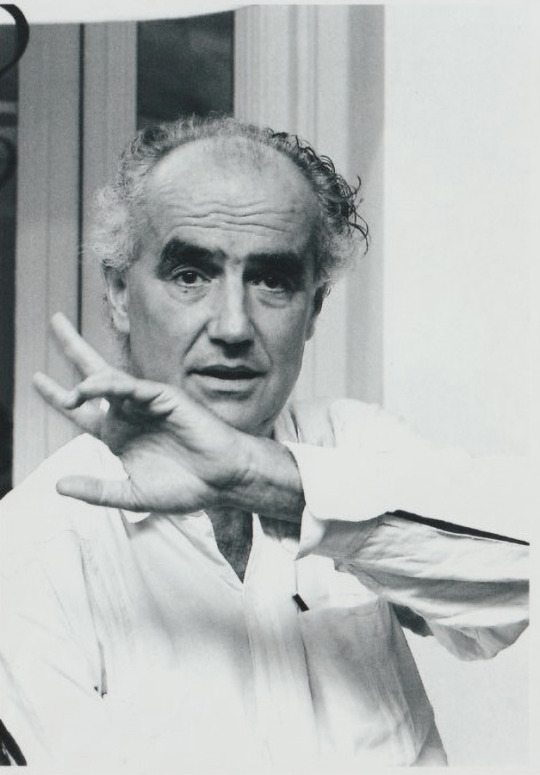
Luigi Nono, January 29, 1924 / 2024 — 100
(image: Carla De Bernardi (photograph), Luigi Nono. Fondazione Archivio Luigi Nono, Venezia. © Carla De Bernardi)
#art#music#photography#luigi nono#birthday anniversary#carla de bernardi#fondazione archivio luigi nono#1920s#2020s
13 notes
·
View notes
Photo

Festival Luigi Nono alla Giudecca. Quinta edizione: 'Contemporanei e allievi', Venezia, November 2022 [Fondazione Archivio Luigi Nono, Venezia. Image: Luigi Nono e Silvia Nono. © Eredi Luigi Nono]
#graphic design#art#music#festival#invitation#luigi nono#silvia nono#fondazione archivio luigi nono#2020s
21 notes
·
View notes
Text

Utopian Listening. The Late Electroacoustic Music of Luigi Nono. Technologies, Aesthetics, Histories, Futures, Granoff Music Center at Tufts University, Medford, MA, [March 23-26], 2016, in partnership with Harvard University, pp. 36-38 [program notes and translations © 2007-2016 Stacey Mastrian]

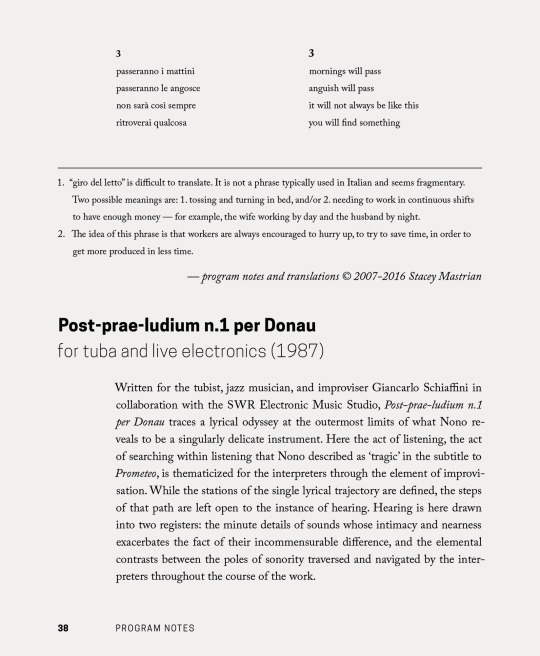
Luigi Nono, La fabbrica illuminata / The Illuminated Factory, Texts by Giuliano Scabia and Cesare Pavese (from Due poesie a T), 1964 [Fondazione Archivio Luigi Nono, Venezia]
#graphic design#art#music#poetry#conference#brochure#la fabbrica illuminata#luigi nono#giuliano scabia#cesare pavese#granoff music center#stacey mastrian#1960s#2010s
15 notes
·
View notes